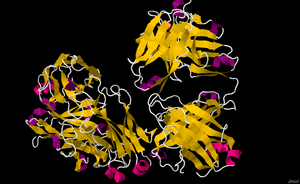The results of an open label extension of a phase II study presented today at the Annual European Congress of Rheumatology (EULAR 2018) demonstrate that lenabasum ontinues to have acceptable safety and tolerability in diffuse cutaneous systemic sclerosis (dcSSc) with no severe or serious adverse events (AE).
"There is a critical unmet need for safe and effective therapeutics for patients with dcSSc," said Professor Thomas Dörner, Chairperson of the Abstract Selection Committee, EULAR. "These results demonstrate a significant step forward in the clinical development of a potentially impactful treatment for people suffering with this devastating disease."
Systemic sclerosis is a rare but serious autoimmune disease which causes hardening and swelling of the skin, as well as joint pain, digestive problems, lung disease, and sometimes problems with the heart and kidneys. The disease occurs in around 30 people per million population per year. The diffuse cutaneous subtype (dcSSc) is even rarer, affecting just one in every four people with the disease. It is linked with early damage to internal organs, as well as painful skin thickening that quickly gets worse. Only half of people diagnosed with dcSSc will survive for 10 years or more.
Medicines for dcSSc are very limited, immunosuppressants are sometimes used although there have been relatively few trials in dcSSc patients specifically because the disease is so rare and difficult to research.
"Our results are very encouraging and reinforce the positive findings from the double-blinded placebo-controlled part of the study with regard to safety and tolerability," said Robert Spiera, M.D., Director of the Scleroderma and Vasculitis Program at Hospital for Special Surgery, Weill Cornell Medical College in New York City and principal investigator. "We look forward to continuing our investigations to assess the role of lenabasum as a new treatment option for patients with dcSSC."
Lenabasum (JBT-101) is a selective cannabinoid receptor type 2 agonist that activates resolution of innate immune response in humans and reduces inflammation and fibrosis in animal models of SSc. It is a synthetic, oral, non-immunosuppressive small molecule.
The results of the initial phase II trial demonstrated that lenabasum had acceptable safety and tolerability in dcSSc and demonstrated consistent evidence of clinical benefit. In addition, changes in gene expression were shown to be consistent with biologic effects of lenabasum on pathways relevant to SSc.
Thirty-six patients, who completed the phase II trial, enrolled into the one year open-label extension (OLE) to receive lenabasum 20mg twice a day. Results suggested improvement in multiple efficacy outcomes measured both from the start of the original study and the OLE. In the 25 subjects who completed a year in the OLE, the mean improvements from the study start included an improvement in ACR CRISS score* by 56%. There was also a reduction in modified Rodnan Skin Score, HAQ-DI†, Physician Global Assessment, and 5-D Itch Questionnaire by 8.6, 0.14, 0.9, and 2.3 respectively. Forced vital capacity percentage predicted was stable from study start with mean change of 0.4%.
The mean duration of treatment in the OLE was 45 weeks with 19 patients completing 60 weeks of treatment. Three subjects discontinued the trial, two due to AEs and one withdrew consent. AEs occurred in 33/36 subjects in the OLE, however only seven had AEs related to lenabasum (none of which were severe). In total, one subject had an AE considered life threatening, three severe, 21 moderate, and eight mild. One subject developed renal crisis involving two severe and one life-threatening/serious AE (deemed unrelated to lenabasum). Most common AEs across all subjects were upper respiratory tract infection (22%), urinary tract infection (14%), diarrhea (11%), skin ulcers (11%), and mild intermediate dizziness (8%).
An international phase III clinical trial of lenabasum has been initiated with results expected in the first half of 2020.



